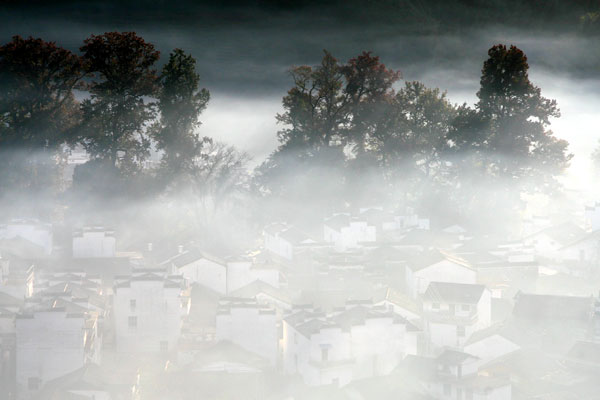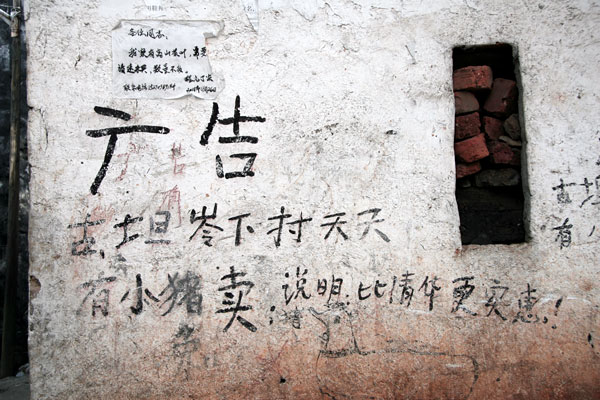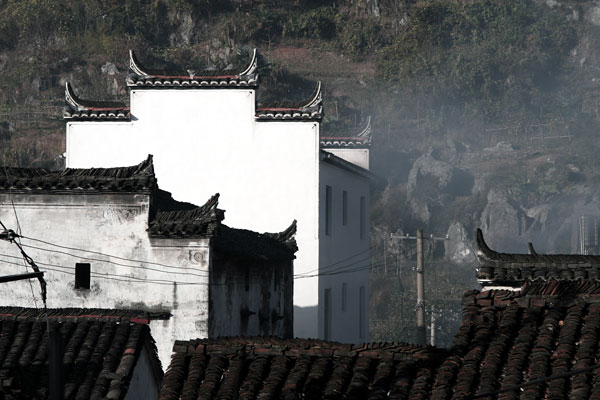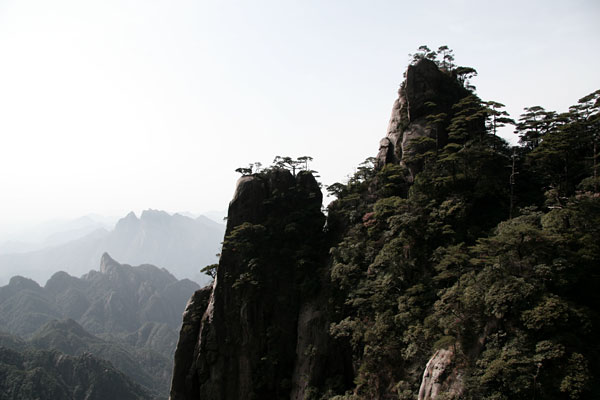
After the spectacular Shicheng village in the early morning, we visited a few largely unknown villages as we slowly made our way back to Wuyuan town. None of these villages were on the official list of "Scenic Spots" governed by the Wuyuan 5-Day Pass, meaning there were no entrance fees to pay. So none of the more popular Big and Little Likeng, Sixi Yancun or Xiaoqi for us -- we're heading straight into the uncharted territory of Wuyuan's pre-commercialized villages.

Starting from Shicheng at the northernmost reaches of Wuyuan's mountainous backroads, the next village was often referred to as the "Roundest Village in China." The little hamlet of Jujing, literally "Path of the Chrysanthemum," was another one of those anonymous gems of genuine Huizhou-style villages hidden within the formerly unreachable mountains. Almost fully enclosed by the looping river, the village resembled a mini Cesky Krumlov with dark, exotic Chinese rooflines instead of baroque belltowers.
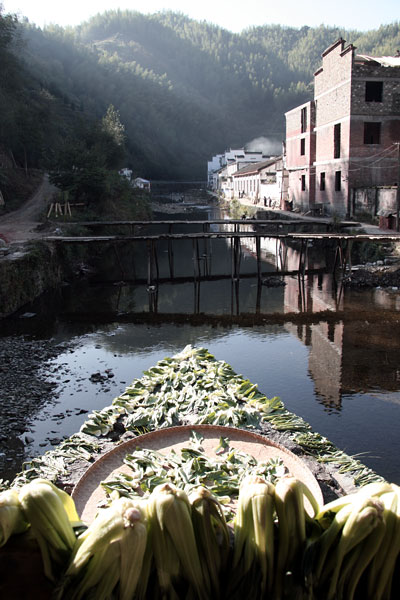
While the Qing Dynasty covered-bridge continued to welcome faraway visitors, decorative sculptures on its balustrades were concealed on this day underneath some sun-dried Chinese cabbages. You know you're walking into an authentic village with absolutely no gentrification or pretence in the name of tourism. This is real stuff.

Remote communities have always survived through self-sufficiency, no matter which part of the world it's in. Here the rice fields were located upstream along the valley, while the impossibly steep hills surrounding the village had long been cultivated into terraced plantations for tea, both the drinkable variety and the oil-producing variety. To this day there was only one small general store, and villagers needing anything more would need to take the daily scheduled bus to Wuyuan town.
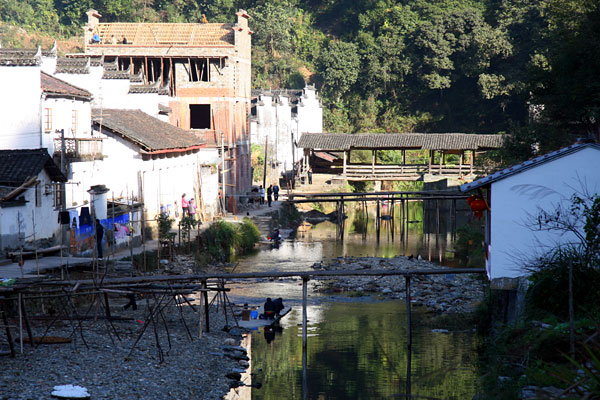
For many centuries this row of awkward wooden-planked footbridges, randomly radiating out in all directions, has bridged the natural moat separating the village from the outside world. Frankly I had my concerns when I had to walk across one of these planks to chase down the storekeeper to refill my cellphone (yes they do have decent cellphone coverage). But as precarious as they may seem, they're actually very secure so long as you don't lose your balance.

The largest and best-maintained building in the village, Jujing Elementary School proudly displayed the Communist Party's five-pointed star at the centre. While the children stayed in their classes, the school courtyard served the public function of sun-drying tea-seeds for communal oil production.
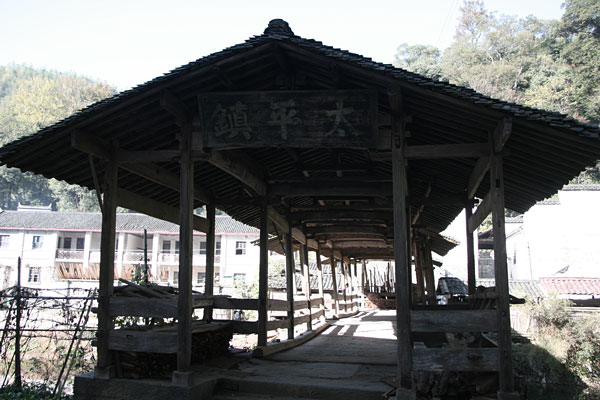
As we left we noticed the former name of the village -- Taipingzhen, or "Peace Town" -- engraved on the plaque over the Qing Dynasty bridge. What is the significance of the old name and why did the inhabitants change it to "Path of the Chysanthemum?" There were no village elders around whom I could ask. That's something I'll likely never know, which is exactly the romance of visiting these mysterious villages.
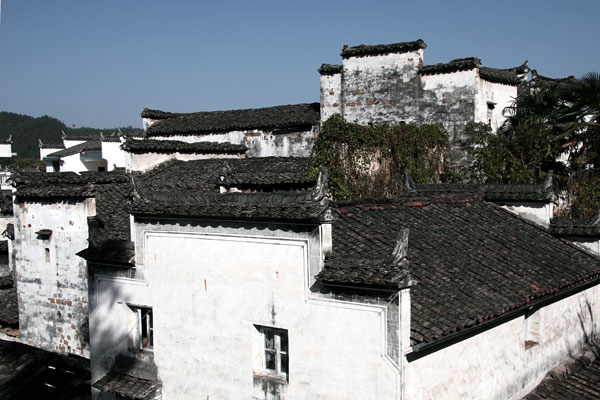
We moved next to Changtan, another charming village just south of the former county seat of Qinghua town. While most tourists visit Qinghua for its landmark Rainbow Bridge, neighboring villages like these receive next to zero visitors. We didn't find even one shop or restaurant, let alone a hotel.

This was a great place to enjoy getting lost within the narrow claustrophobic alleys, all surrounded by tall, whitewashed firewalls topped with curving roof edges. The landscape here was flatter than Jujing's, and the villagers made productive use of their farmland.

But the pastoral life seemed to be on the verge of disappearing. Just 200m away loomed the construction site of one of Wuyuan's countless new housing developments which, when finished in a year or two, will surely attract hundreds of suburban families with their suburban needs. At the same time the younger generation continue to gravitate towards the cities and depleting these villages. After more than 20 years of the one-child policy and its skewing effect on demographics, it's difficult to be optimistic about the future of these beautiful villages.
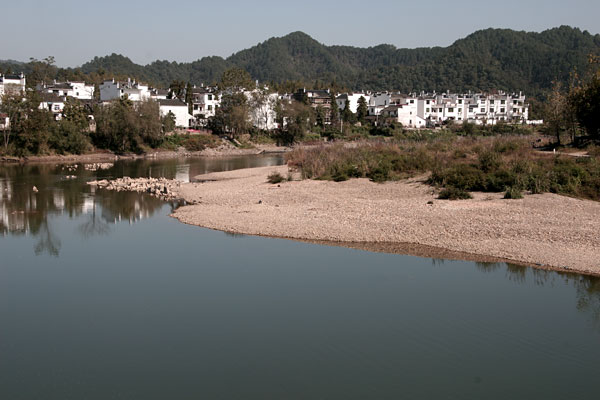
Further down the road near the turnoff to Sixi Yancun, we made a brief stop at another small settlement named Zhangcun. This village used to be well-known for one of the most unusual and picturesque bridges in Wuyuan, a long, primitive footbridge known simply as the Zhangcun Wooden Bridge. After the destruction of yet another reincarnation of the bridge in recent floods, we arrived at the village with no expectations of what we would encounter.

Much of the village was comprised of newer farmhouses, albeit rebuilt in the traditional style. After 15 minutes we stumbled upon the old Citang, or ancestral temple for worship among the clan. As we entered the gigantic dilapidated shell of what must have been a glorious temple, our taxi driver Ms. Cheng joked with my wife that it's only less than a century ago when this was a forbidden place for women.
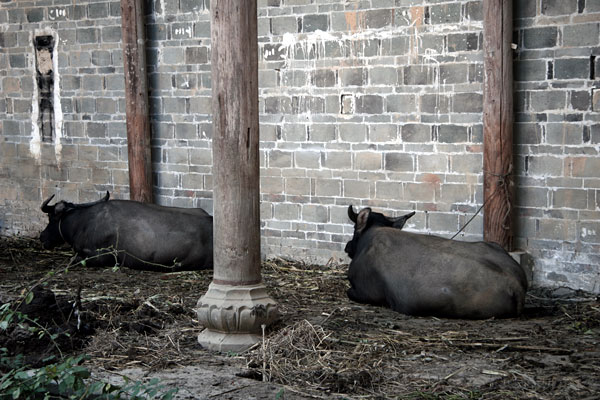
Now this place had been relegated to the function of a barn for the local cattle population, with cattle ropes tied around the ancient cedar pillars and sculpted stone bases. Every self-respecting village in Wuyuan, or almost anywhere else in rural China for that matter, must have had a Citang in the past. Is there still time to revitalize heritage buildings such as these, or is it already too late? That's something for the citizens of Wuyuan to decide.

The final village of our visit was also my favorite discovery in Wuyuan -- I had never heard of this rustically enchanting village before, and it's definitely not on any tourist map anywhere. Even if you search for the name of Zhaocun on the Chinese Baidu Maps, the village doesn't show up until you're at the scale of 100m. This is as off-the-beaten-path as it gets.
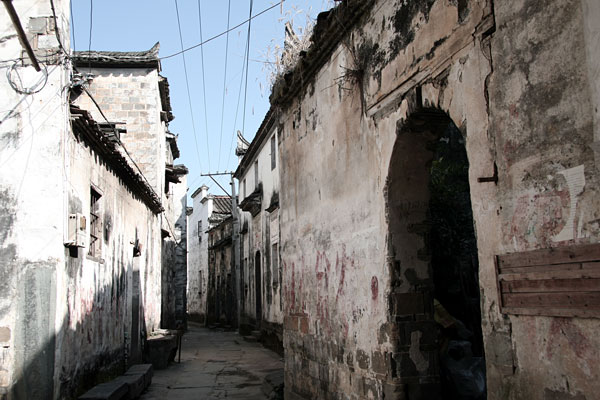
Upon entering the village you would immediately dive into an medieval labyrinth of narrow zigzagging alleys, stretching out in three directions like a broken spider web. Every turn at every crossroad seemed to reveal another stunning picture to the first-time visitor while the locals carried on their daily lives, blissfully unaware of the raw unpretentious beauty -- and the tourism potential -- of their ancestral home.
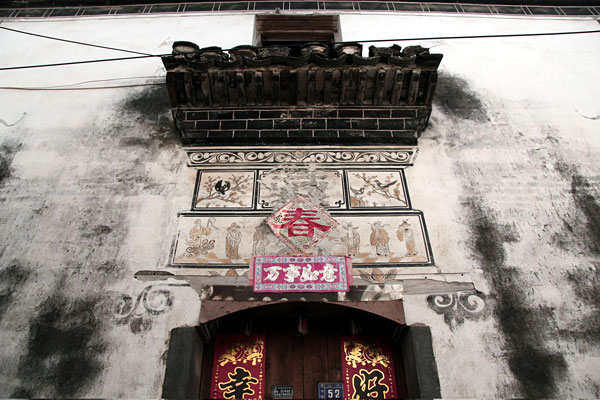
We were far from the only outsiders stumbling upon this untouched corner of Wuyuan -- on this day a group of Chinese art students had already staked their easels around the village at seemingly odd spots, not all of them obviously scenic at first glance. The locals didn't seem to mind the random strangers outside their doorways though, or perhaps this had already become a weekly occurrence.

This was essentially the Wuyuan that I had come for -- not the Wuyuan of planned mass tourism, of aggressive hawkers and alleys full of souvenir shops, but a Wuyuan still belonging to the genuine descendents of the once-powerful Huizhou merchants, still living their laid-back lives in their classical home and courtyards, many dating from the Qing Dynasty or beyond.
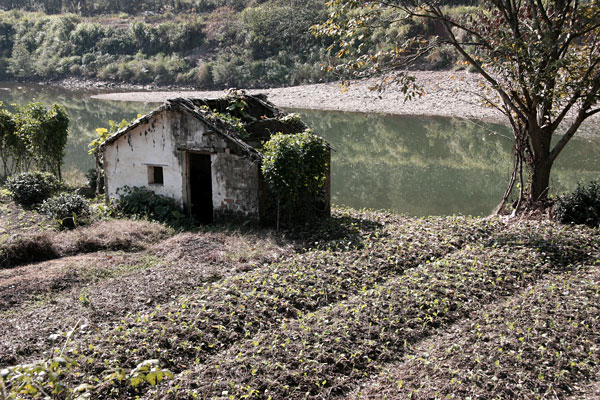
So we concluded our tour of Wuyuan with visits to five villages, my favorites being Shicheng, Zhaocun and Jujing in this particular order. Currently Shicheng requires an entrance fee only during the peak autumn foliage season of November and December, while Zhaocun and Jujing remain largely undiscovered and require no entrance fees. If you're independent travelers like us and are not intending to purchase the Wuyuan 5-Day Pass, these are probably some of the best spots outside of the "official" tourist route.
RESTAURANT REVIEWS
Food Review: CUNLI CUNWAI (Wuyuan Town, Wuyuan)
Address: 162 Wengong Beilu, Wuyuan
Hours: 11:00 – 22:00 (unconfirmed; based on observation)
Website/Map: From Baidu Map
Directions: Situated at the northeast corner of the intersection of Wengong Beilu and Dongsheng Lu. Just hire a taxi -- Wuyuan Town isn't that big and everyone seems to know the place.
Widely rumoured to be the best restaurant in Wuyuan County in terms of price-to-quality, Cunli Cunwai was the place I specifically picked for trying out Wuyuan most famous local dish. In fact we specifically stayed at its associated hotel upstairs for the convenience of getting to the restaurant -- that's how far its reputation goes. While the hotel wasn't so great (as expected), the food itself was quite worth the trip.
So what's this famous local dish that we were so keen on trying?
If you've been to Jiangxi Province, you'd probably think that Jiangxi cuisine is all about suicidal levels of spiciness, which is generally true. But Wuyuan has historically belonged to Anhui Province prior to the Communist era, and its culinary lineage is much closer related to the distinct but milder taste of Huizhou cuisine. Think freshwater fish, organic wild vegetables and other farmhouse dishes.
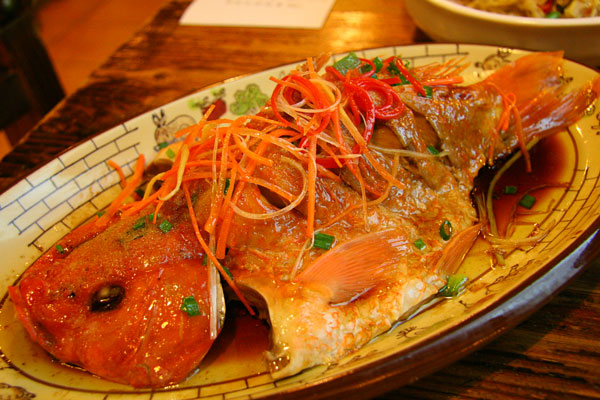
Wuyuan's most famous dish -- the Steamed Red Purse Carp -- is a platter of alluring bright orange to curious foodies, and a nightmare to aquarium enthusiasts. No matter how the chef plates and garnishes the fish, it still looks eerily similar to any ornamental koi fish (ie. Nishikigoi) swimming in the garden ponds of Japan and Eastern China. But here in Wuyuan it's not only a local favorite for generations, but an auspicious dish elevated to the tables of China's state banquets.
Our fish could almost pass for a Cantonese dish -- gently steamed in a mildly sweet, light soy sauce and topped with julienned ginger and pepper. It was also huge for its measly price of RMB 36 (CAD$6) and, most importantly, carried almost no "muddy taste" for a freshwater fish. The only possible complaint was that it was steamed so lightly that the meat next to the backbone was just undercooked. Decent dish at a great price nevertheless.

Our next dish was an even better deal. Late autumn was the start of bamboo shoot season, and we decided to order the region's famous cured bamboo shoots. Our Nongjia Lasun (Farmhouse Cured Bamboo Shoots) came reconstituted in a savory broth and sliced absolutely paper-thin into a refreshing, crispy dish with just a tinge of spiciness. In fact this was probably one of my favorite bamboo shoot dishes in recent memory, at the cost of only RMB 18 (CAD$3).

And the good deals kept coming. Cunli Cunwai was having a promotion menu on certain local dishes, including this pot of Simmered Free-Range Chicken with Caterpillar Mushrooms for an amazingly cheap RMB 30 (CAD$5). As far as we knew genuine free-range chicken typically went for around RMB 80 per whole chicken in restaurants, and Caterpillar Mushrooms, an immunity booster in Traditional Chinese Medicine, was never cheap either. Inside this claypot was half a chicken (definitely free-range, with the recognizably sweeter, chewier meat and clearer broth) simmered with the thin, enoki-like mushrooms into a delicious chicken broth, and sold at a rock bottom promotional price.
Even after a large domestic beer (probably a Xuehua) and some rice, the grand total still came out to less than RMB 100. Cunli Cunwai was a definite bargain -- and forget Hong Kong or Shanghai prices -- even at local pricing standards. We just spent RMB 120 at Sanqingshan the previous night, and the food was five notches below the quality here.
One last recommendation: ask for the "No Receipt" (Buyao Fapiao!) menu if you can speak Chinese. Now this was getting weird even for China. I don't know how they manage to escape attention from the local Taxation Department, but as a traveler I'm quite content to just follow the local custom!
Bill for Two Persons
| Steamed Red Purse Carp (Hebao Hongliyu) | RMB 36 |
| Farmhouse Dried Bamboo Shoots (Nongjia Lasun) | RMB 18 |
| Simmered Free-Range Chicken with Caterpillar Mushroom (Chongcaohua Duntuji) | RMB 30 |
| Bowl of Rice | RMB 1 |
| Plate Set x 2 | RMB 2 |
| Large Beer | RMB 10 |
| TOTAL | RMB 97 (CAD$15.4) |
Food Review: XIANYU XIANROU TESEDIAN (Wuyuan Town, Wuyuan)
Address: Huangcheng Beilu, Wuyuan
Hours: 11:00 – 21:00 (unconfirmed; based on observation)
Website/Map: N/A
Directions: Near the corner of Xingjiang Lu and Huangcheng Beilu. It's probably easier to show the picture below to a taxi driver.
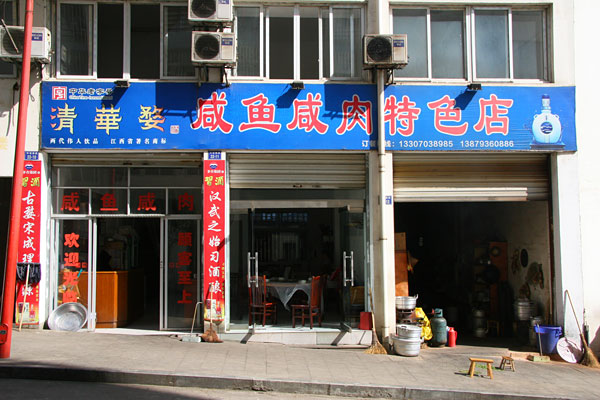
Recommended to us by a local here in Wuyuan Town, this little mom-and-pop eatery serves up great authentic local dishes at very cheap prices. In fact, cheaper prices than even Cunli Cunwai. But here's the catch -- I wouldn't know how to get here without a taxi, and I don't know the exact address. I only know that it's within walking distance from the County Government Office. Hence I've taken a photo of the storefront for those intrepid travelers wanting a little adventure.

While Xianyu Xianrou literally means "Salted Fish and Salted Meat," we didn't spot much of either on the menu. For reasons unknown to us, the owner's daughter seemed absolutely convinced that we would enjoy their house specialty chicken feet. Fine, bring it on, I thought, as we're accustomed to these in Cantonese Dim Sum anyway.
These actually tasted quite good. The preparation here was quite different from the reddish-orange type typically seen in Hong Kong -- there was no deep-frying to loosen the chicken skin (and thus a little healthier), and the sauce consisted of a heavier, darker soy with a hint of hot green peppers. A pretty good start to the meal, but the next two dishes were even better.
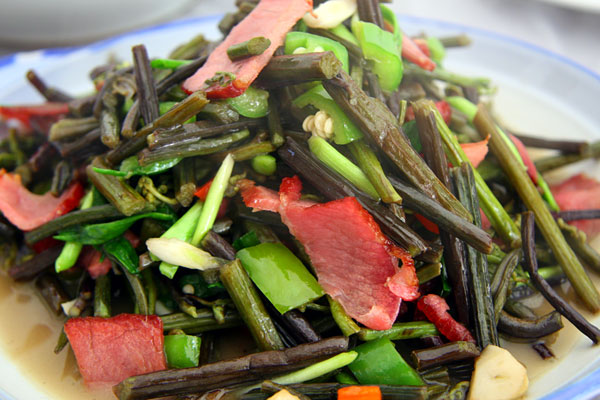
If the restaurant was confident enough to put Salted Meat on its name, I thought, they must have some excellent cured ham in store. As in the rest of Southern China, Wuyuan's Larou is typically a whole leg of pork, salted, air-dried and aged before it becomes ready for consumption. Our dish of stir-fried ham was mildly salty, very lean, and came infused with the complex flavor one would expect of quality cured meat. While the fiddleheads were not spectacular, it's something we rarely get in Canada. This dish was so good -- it didn't last very long on the table.
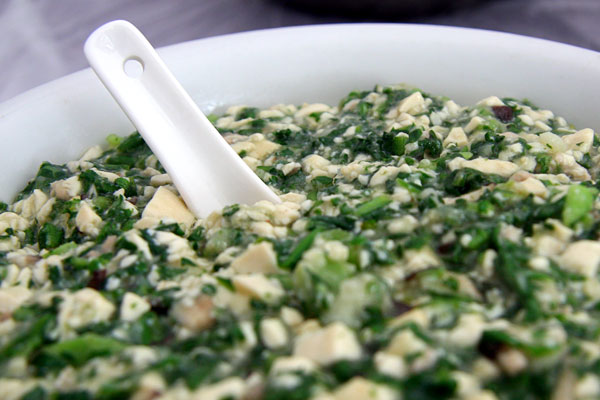
But it was the plainest and cheapest dish that turned out to be the best. This Hudoufu, or Mashed Tofu, belongs to a whole genre of so-called "mashed dishes" unique only to Wuyuan and nowhere else in China. The concept is simple -- dice and stir-fry the ingredients until done, then add fluids and rice flour until reaching the desired consistency.
Here the common peasant fare of tofu and chrysanthemum greens were transformed into a chunky yet harmonious mixture of fragrant, highly addictive concoction, perfect for its main purpose as a topping on steamed rice. I was sure they're cooking with artery-clogging lard but I didn't care -- it was just amazingly good! And at the unbelievably cheap price of RMB 16 (CAD$2.5), this simple dish was easily my favorite.
Bill for Two Persons
| Red Braised Chicken Feet (Hongshao Fengzhao) | RMB 30 |
| Stir-fried Cured Ham with Fiddleheads (Larou Chaoshanjue) | RMB 28 |
| Mashed Tofu (Hudoufu) | RMB 16 |
| Rice x 2 | RMB 2 |
| Plate Set x 2 | RMB 2 |
| TOTAL | RMB 78 (CAD$12.4) |
ACCOMMODATION
Hotel Review: CUNLI CUNWAI (Wuyuan)
Address: 162 Wengong Beilu, Wuyuan
Price: RMB 138
Website/Map: Booked from CTrip.com
Directions: Situated at the northeast corner of the intersection of Wengong Beilu and Dongsheng Lu.
Once again, we booked this hotel only for the convenience of dining downstairs at the excellent Cunli Cunwai restaurant. I wouldn't have considered this hotel otherwise.
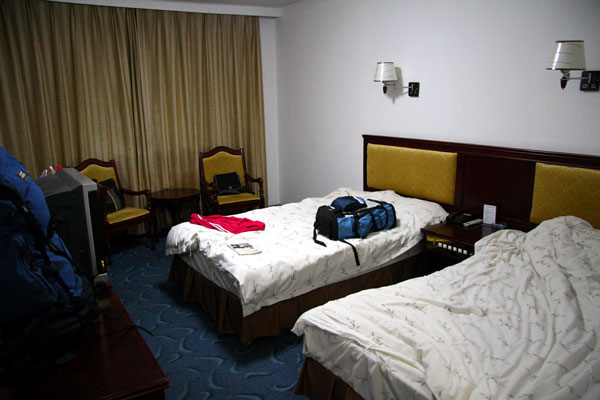
The hotel wasn't all bad -- I did find several things going for it: one of the best value restaurants in Wuyuan, friendly and helpful reception, spacious room, desktop computer inside the room with free internet access, and the cheapest stay of our entire trip at RMB 138 (CAD$22).
But there were also a few caveats: below average hygiene, water leaking from the shower stall to the rest of the bathroom, and thin, non-sound-proofing windows facing a busy section of Wuyuan's busiest road. Thanks goodness for our own slippers and earplugs.
If I ever end up in Wuyuan again, I would stay at the Super 8 down the road and take the taxi to Cunli Cunwai restaurant. At least it's the devil I know.



